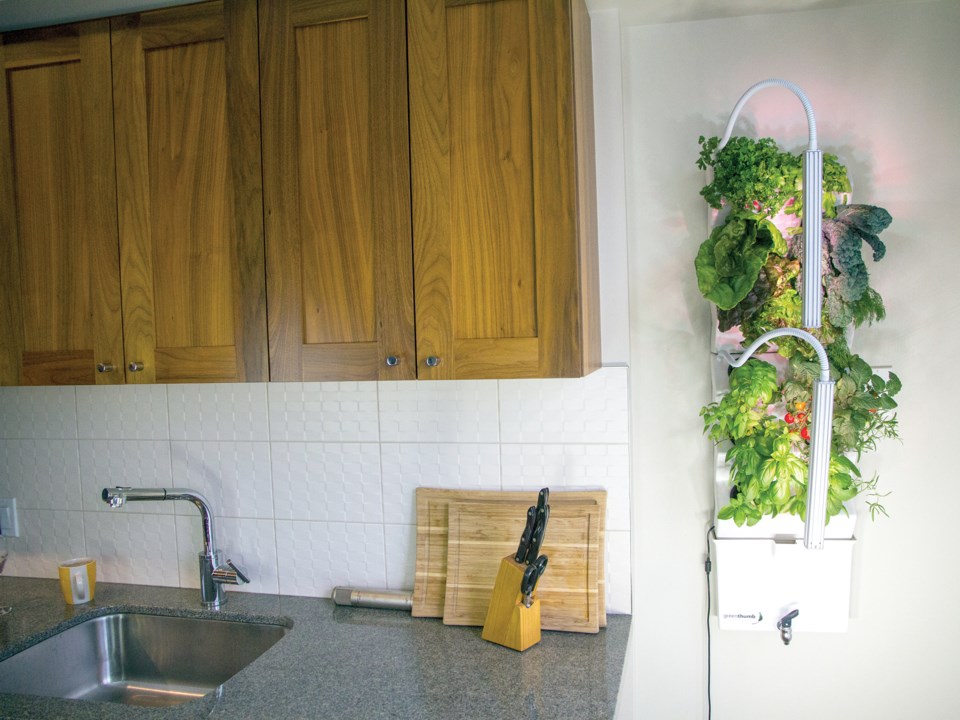Five years ago, Jen McGuinness had a major pot problem. Or, rather, a container conundrum.
At the time, the now-Powell River resident was living in a townhouse under the shade of the Stawamus Chief in Squamish with a patio full of herb and vegetable plants.
“All we wanted was a place to sit,” said McGuinness, “so I started researching on how to make an indoor garden that was more vertical.”
Inspired by the living wall tapestries one might find in the pages of their favourite home and garden magazine, McGuinness began adapting the idea to suit edible plants.
“Most of the tomatoes and peppers and cucumbers you get at the grocery store now are all hydroponically grown,” she said. “There were a couple of countertop systems available, so I knew it was possible.”
However, McGuinness was insistent her system be both modular and space-conscious, so as not to merely shift the problem from the patio to the kitchen.
“I had a pretty solid list of things the design had to meet,” she said. “It had to be vertical, it had to go on the wall. We also wanted to make it automated. Obviously, some people are into growing; some people are not.”
McGuinness came up with a few sketches, contacted an engineering firm and eventually gained the attention of the National Research Council of Canada, who offered financial assistance. Prototypes soon followed and Green Thumb Technology was born.
The company’s VeggieWall system, which will see its first shipments go out the door later this year, uses a soil-less method and a flexible gooseneck LED light designed to simulate optimal growing conditions indoors. Lightweight and compact, it can hang on a wall much like a picture frame, providing a leafy landscape that also happens to yield fresh herbs and vegetables at record speed.
“It’s ideal for growing all different types of greens,” said McGuinness. “Lettuce, kale, Swiss chard, Asian greens, different mustards, tomatoes, peppers, small varieties of cucumbers and especially herbs. I put basil in almost everything now because it grows so well and so fast.”
As a general rule, plants grow two to three weeks faster on the VeggieWall than they might in an outdoor garden or greenhouse.
“The roots don’t have to grow and source nutrients the same way, so they get a jump start,” said McGuinness.
Mother Nature owner Ron Pfister has noticed an influx of indoor gardening products on the market in recent years, including the VeggieWall and many of its competitors. While McGuinness’ vertical system is not currently available at his Duncan Street nursery, he does sell many of the components needed for growing microgreens, herbs and other plants on horizontal racks.
“People are really getting into it,” said Pfister. “To do a single tray you’re only looking at an area of about two square feet, usually on your kitchen counter.”
The most basic system retails for less than $100 and uses little more than a seed tray, a plastic dome and a fluorescent light. With the addition of an optional heat mat the harvesting can begin as early as 10 days after the first planting. After all, microgreens are essentially the tender shoots of salad vegetables just after they have developed their first set of leaves.
“There’s about 40 times more nutrition in a microgreen version versus the actual full-grown plant,” said Pfister. “They’re great in sandwiches and salads because you can really taste them. Arugula, as an example, has kind of a peppery taste. It’s fantastic. And the pea shoots actually taste like peas.”
The trend has not just rubbed off on gardeners and gourmets, either. Now, architects and interior designers have begun to take notice of the hobby as well, coming up with compact and aesthetically-pleasing ways to incorporate indoor gardening into their clients’ construction and renovation plans.
“I know if I was to build a house again I’d have a specific room where I could grow microgreens and herbs,” said Pfister. “That’s really the way to go.”
In the case of Pfister and McGuinness, the ability to harvest fresh produce on demand, rather than buying it in predetermined amounts, has reduced waste and saved money; not to mention providing a wintertime bounty that simply would not be possible in an outdoor garden.
“Usually, come fall your harvest is done and you’re back to the grocery store produce,” said McGuinness. "It’s not as fresh, it doesn’t have the same taste and it doesn’t have the same nutrient density in it, so a big part of my enjoyment has just been being able to grow things in my kitchen for all 12 months of the year.”
And, of course, to be able to fit a chair or two on her patio once again.



